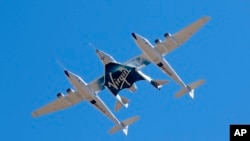The company's twin-fuselage VMS Eve carrier plane took off from Virgin Galactic's Spaceport America site around 16:17 GMT, Virgin Galactic said on Twitter. The craft carried the VSS Unity spaceplane with a crew of six company employees to a planned altitude of roughly 16,000 meters.
There, VSS Unity separated from its carrier craft and ignited an engine to boost itself toward space, the company confirmed on Twitter.
Virgin Galactic pilots Jameel Janjua and Nicola Pecile piloted the carrier aircraft VMS Eve. The spacecraft, released from the carrier craft, ignited a rocket engine and climbed to an altitude of roughly 80 kilometers, the U.S.-recognized boundary of Earth's atmosphere, where the crew experienced weightlessness for around 3 minutes.
The test mission, lasting roughly 90 minutes from takeoff to the spaceplane landing after spending three minutes in microgravity, follows the type of rides Virgin Galactic intends to provide for a backlog of some 800 customers. Most have paid between $250,000 and $450,000 for a ticket.
Virgin Galactic's Unity 25 mission comes 22 months after billionaire Branson and employees rode to the edge of space aboard its centerpiece SpaceShipTwo spaceplane. It had hoped that high-profile mission would open the door to routine flights soon after.
The company in April conducted a successful glide test with VSS Unity, dropping it at just over 15,000 meters for a free-fall back to its runway, without having ignited its engine to go toward space.
A safety probe into Branson's flight by the U.S. Federal Aviation Administration delayed the plans, as did a lengthy spacecraft upgrade period that lasted longer than Virgin Galactic anticipated.









Forum